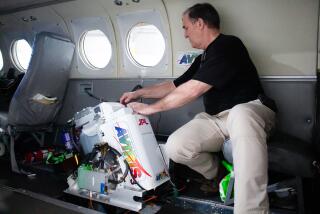Researchers Brave Cold in Study of Warming
- Share via
RENO — A scientist braved numbing subzero temperatures this summer to uncover more than 800 years of Earth’s climate trends that may reveal whether the planet is warming up because of modern man’s excesses.
Dr. Kendrick Taylor of Reno’s Desert Research Institute endured temperatures that plunged to 40 below zero Fahrenheit and occasionally warmed to freezing as he joined a team of American researchers on the six-week Greenland Ice Sheet Project 2.
“We have to understand what happened in the past to test our theories and ideas about what will happen to the climate in the future,” Taylor said.
“This was the first year so we’re still analyzing data and no great discoveries were made. But when the project is finished, this will definitely give us some help in answering the big question about the greenhouse effect.”
The Greenland project, funded by the National Science Foundation, is the most ambitious drilling effort ever undertaken by the United States and parallels studies by European nations and the Soviet Union.
Project scientists plan to drill 10,000 feet down into the Greenland icecap that has remained frozen from the Earth’s past ice ages to review a panorama of environmental history spanning 200,000 years or more.
During this summer’s first season on the project, Taylor said 24 scientists and workers drilled a hole 5.2 inches wide and more than 650 feet deep to unearth about 800 years of environmental history.
“We were definitely working in harsh conditions; it got up to freezing one day,” Taylor said. “But overall it was a good experience. And, believe it or not, the food was great. Some people gained weight.”
Scientists generally worked 10- to 14-hour days, he said, and did not have much time for recreation, although some hardy athletes set up a volleyball net for a few games.
“We were pretty comfortable most of the time,” he said. “We slept in heated tents that were about 10 degrees, and we have a few heated buildings for showers and an outhouse.
“I haven’t decided yet, but I think I’m going back next year. The project will last four three to four years.”
The scientists are exploring compacted ice at the base of the Greenland ice sheet that is composed of snow, dust and small amounts of chemicals from two ices ages ago.
Traces of impurities in the ice layers provide a chronicle of changes in air, sea temperatures, precipitation, storm severity, biological evolution, man-made pollution and solar activity.
Gases such as carbon dioxide and methane, which are thought to be contributing to the greenhouse increase in the Earth’s average temperatures, can can be measured in the ice layers.
NASA scientists have estimated that if humans do nothing to cut down on the current amounts of carbon dioxide pumped into the atmosphere, temperatures in the year 2050 will be six to seven degrees higher than they are today, producing enormous climate changes.
The level of the ocean could rise anywhere from one to six feet as polar icecaps melt and the frequency and severity of storms would increase, according to NASA scientist James Hansen.
Causes of the greenhouse effect include the use of chlorofluorocarbons in refrigerants and aerosols, burning fossil fuels such as coal and gasoline and cutting down forests and plant life that renew the Earth’s oxygen supplies.
The National Science Foundation is coordinating the U.S. Greenland Ice Sheet Project with the European Science Foundation, which is funding extraction of an ice core 20 miles away from the American project.
The two ice cores from the Greenland Ice Sheet will let scientists compare and validate their data, Taylor said.
The deepest ice core obtained by Soviet scientists at Vostok in the heart of East Antarctica was about 7,200 feet long and contained a record going back 160,000 years or more.
Taylor, a geophysicist with the Desert Research Institute’s Water Resources Center, was the scientist in charge of electric conductivity tests on the Greenland Ice Sheet project this past summer.
His research into the relative acidity in the ice has so far produced evidence of several volcanic eruptions near the summit of the Greenland Ice Sheet.
“It’s really amazing how much information you can obtain under studies like this,” Taylor said. “You can pull gas samples out of the ice and tell what was in the air that day years ago.”






